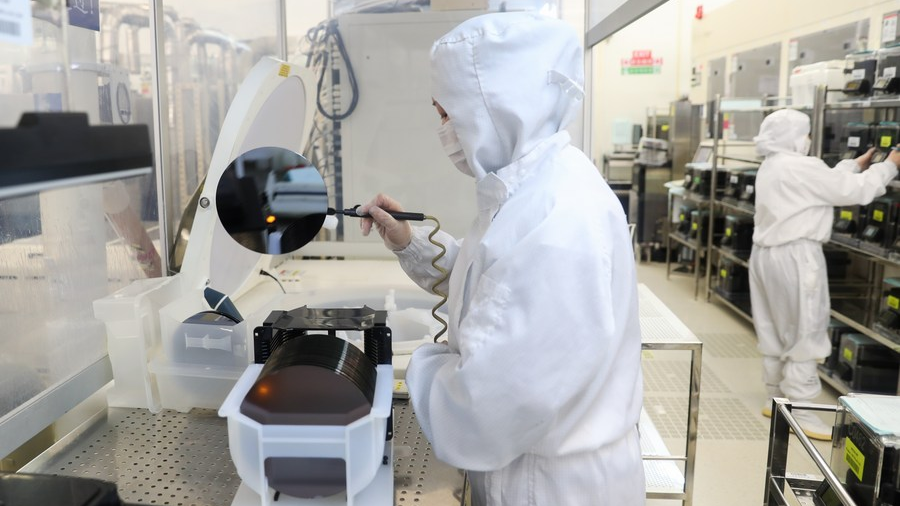
Workers are operating manufacturing equipment in a workshop of a semiconductor company in Shanghai, east China, February 10, 2020. /Xinhua
Workers are operating manufacturing equipment in a workshop of a semiconductor company in Shanghai, east China, February 10, 2020. /Xinhua
Editor's note: Keith Lamb is a University of Oxford graduate with an MSc degree in Contemporary Chinese Studies. His primary research interests are China's international relations and "socialism with Chinese characteristics." The article reflects the author's opinions and not necessarily the views of CGTN.
If you've ordered anything that relies heavily on semiconductors, such as an electronic car or a laptop, then you might, even months later, still be waiting for delivery. The standard excuse for this inconvenience often boils down to COVID-19. For example, The Economist explains that just-in-time production, in the automobile industry, meant a lack of access to chips when predicted slowdowns didn't materialize. Then due to lockdown more purchases of home electrical office equipment, for work, and gaming consoles, for entertainment, further drove up demand for semiconductors.
However, because semiconductors are both essential and increasingly in demand chip foundries never stopped running during lockdown. As such, if it was merely a matter of a COVID-19 supply and demand "blip" then tech-watchers wouldn't predict shortages to last until 2023. Consequently, while COVID-19 may play a role, it is also an altogether more nefarious dumping ground for excuses that distract consumers from more fundamental hegemonic actions that will drive up consumer prices, curtail technological advances, and even threaten our shared green technological future.
A more fundamental factor is the U.S. tech war against China, which focuses on the semiconductor industry. Here Chinese firms such as Huawei, ZTE, Hivision, and hundreds of others, have all been restricted from accessing advanced semiconductors. In Huawei's case, this led to a huge spike in orders to stock up on semiconductors before sanctions came into force which could, in part, explain shortages.
Of course, one might imagine that with Chinese tech being artificially pushed out of the market, there would eventually be a surplus of semiconductors for Western products. However, the tech industry is interlinked with components for each product coming from many suppliers to then be assembled in China. Simply put, by restricting Chinese firms who are interlocked in a global tech supply chain there will only be an inevitable knock-on disruption to all electronic products.
At any rate, there is a contradictory situation where in the quest to balance profits with geopolitical goals U.S. tech firms have been given temporary export licenses to Chinese firms such as Huawei and chipmaker SMIC. However, this has not solved the problem as the U.S. is not exporting cutting-edge chip technology. This bizarre situation is further compounded by the "bipolar" fact that non-U.S. suppliers, who manufacture advanced semiconductors, like TSMC have been forced to pull out of the China market. In addition, considering export licenses are temporary one can expect there to be further hoarding.

The Apple M1 chip is introduced during a virtual product launch in Tiskilwa, Illinois, U.S., November 10, 2020. /Getty
The Apple M1 chip is introduced during a virtual product launch in Tiskilwa, Illinois, U.S., November 10, 2020. /Getty
Consequently, the problem then is less about a chip shortage and more about artificial meddling in supply chains. In an attempt to maintain technological hegemony, the U.S. is trying to curb all non-U.S. semiconductor firms while boosting its own companies. Not only is the U.S. attempting to control the supply of advanced semiconductors to China it also seeks to prevent China from advancing its own semiconductor industry.
For example, the Dutch firm ASML has been restricted from selling the Chinese chipmaker SK Hynix the equipment needed to upgrade its semiconductor production. With the current geopolitical turmoil, Intel's plans to take over GlobalFoundries' chip plant in Chengdu have been abandoned. Instead, the U.S. is making sure that the advanced semiconductor industry is moved to the U.S. For example, Samsung, which has acceded to U.S. pressure, now plans to build a chip plant in Texas.
Erratic U.S. interference with market forces inevitably means the tech industry, which usually excels at future planning, will be less able to plan rationally for increased future demand for semiconductors and this, in turn, will lead to future supply disturbances. As China's technological productive potential is decoupled efficiency will decrease leading to a profit downturn and less surplus for R&D which will slowdown tech advancements. This predicament will be even more pronounced, in the future, considering technology, such as the Internet of Things and self-driving electric vehicles naturally demand more semiconductors.
Already U.S. efforts to strangle China out of advanced semiconductor production are affecting living standards as consumers are inconvenienced by long waits for essential electronic items. If in future, China's production capacity is not allowed a greater contribution to global semiconductor production then prices for electronic goods will only rise which will further make a dent in living standards. Even more worrying is the environmental concerns that could arise should the future production of semiconductor-hungry technology, such as electric vehicles, not be met.
Currently, the slowdown in the delivery of electrical products is being propagandized away as supply and demand problems related to COVID-19. However, the real problem is a manmade crisis caused by U.S. attempts to control the semiconductor industry. Thus, for the purpose of maintaining U.S. tech hegemony, our shared technological dream is being hijacked by a small elite. Like former catastrophic events, like 9/11 and Iraq's WMD, COVID-19 will continue to be used to camouflage undemocratic actions in the international realm while also justifying increased state responses to social unrest at home.
(If you want to contribute and have specific expertise, please contact us at opinions@cgtn.com.)

